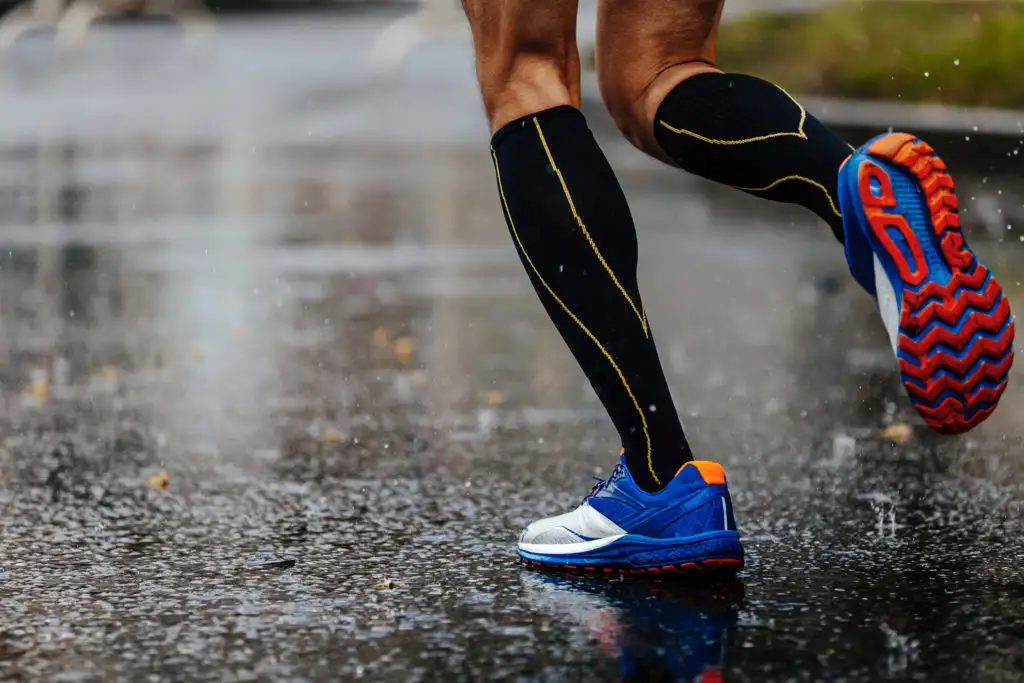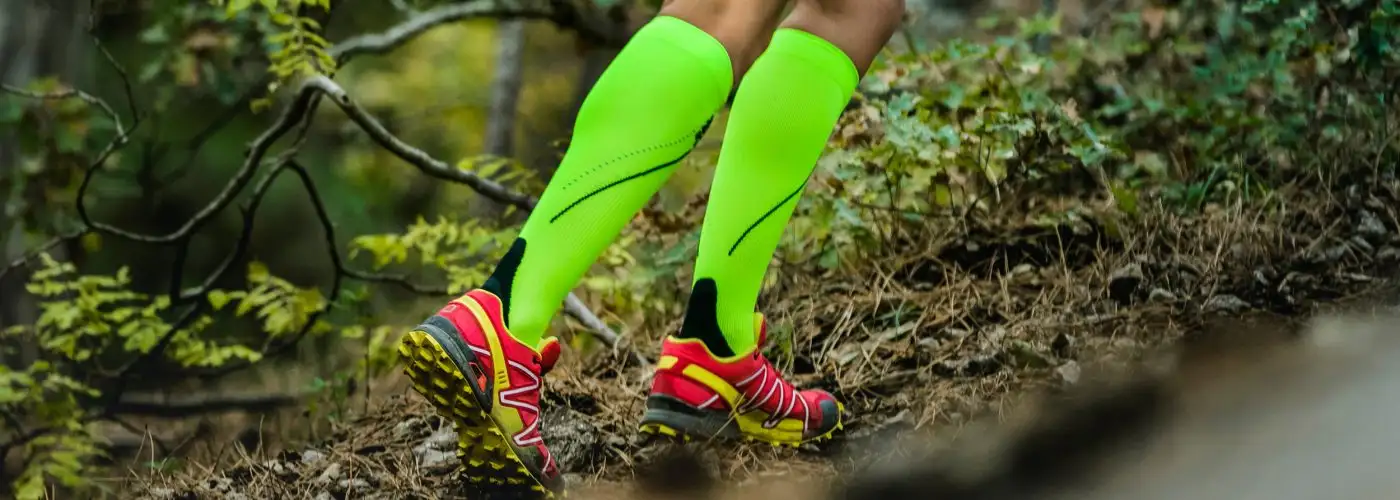Between the dry air, pressure changes, and cramped conditions, sitting on a plane for hours can be tough on your body. But dehydration and stiff muscles aren’t the only hazards associated with long flights. Sitting in one position for too long can cause swelling in the lower legs and increase your risk of blood clots, which is why travelers might want to add compression socks to their must-pack list.
Compression socks, also known as compression stockings, are often recommended for travelers on long flights. But do compression socks really work? I reached out to medical experts to find out.
What Are Compression Socks?

Compression socks are supportive, snug-fitting socks that typically come up to the top of your calf and encourage the healthy circulation of blood from your ankles back up to your heart. Most offer graduated compression, with more pressure at the ankle than the calf.
“Compression socks work by applying a constant pressure to the ankle and calf area,” explains Dr. Doug Tumen, a podiatrist at Hudson Valley Foot Associates in Kingston, New York, and the author of Ask the Foot Doctor: Real-Life Answers to Enjoy Happy, Healthy, Pain-Free Feet. “This prevents pooling of blood in the legs, which is a risk factor for a blood clot. Arteries bring the oxygenated blood pumped from the heart to all areas of the body while the veins work to bring the blood back to the lungs for fresh oxygen. The compression socks aid in this venous return.”
What Are the Benefits of Compression Socks?
Compression socks are a good bet for long-haul flyers, who are at increased risk of blood clots on flights over four hours, according to the World Health Organization (WHO).
“For travelers, the most common use is for long flights to prevent swelling in the feet and legs, and also more importantly to minimize the risk of a dangerous blood clot, called a DVT or deep vein thrombosis,” says Dr. Tumen. “The risk of a DVT in the leg is that a piece of the blood clot can break off and travel to the lungs. This is called a pulmonary embolus and can be fatal often without warning.”
Although DVT is most often linked to air travel, WHO notes that it can be a risk on long car or train rides as well.
Compression socks have other benefits for travelers besides cutting down on your DVT risk. Dr. Jonathan A. Levison, a vascular surgeon at The Cardiovascular Care Group in New Jersey, explains that compression socks can help reduce the uncomfortable swelling in the legs that’s common on long flights due to inactivity, changes in air pressure, and exposure to high-sodium foods: “Compression socks/stockings will help prevent the accumulation of fluid in the lower part of the leg where the symptoms from swelling are usually most notable. … I wear them daily as a surgeon, as I am standing in one place for extended periods.”
Compression socks may also be useful for travelers who plan to be active once they arrive in their destination. “Scientific studies so far are conflicting, but anecdotally some elite and novice runners swear by compression stockings worn during or immediately after a run to reduce muscle soreness [and] fatigue and produce faster lactate recovery,” says Dr. Tyeese L. Gaines, founder and CEO of NOWmed Walk-In Urgent Care in Jersey City, New Jersey. “The theory is that the compression helps blood circulate better, which in turns allows more oxygen to get to the tissues.”
Who Should Consider Wearing Compression Socks?
Most travelers can benefit from wearing compression socks, but they’re particularly important for people with certain health conditions. “Those at higher risk for clots, such as pregnant women, obese people, people with clotting problems (including cancer patients), [people with] varicose veins, and those who have already had a clot, should see their physician for a prescription to make they are getting the correct size and amount of pressure,” advises Dr. Monique May, a board-certified family physician.
Dr. Tumen notes that smokers and women on birth control pills may also have increased clotting risk.
Is There Anyone Who Shouldn’t Wear Compression Socks?
While most travelers can wear compression socks without issues, they might not be a good fit for those with select medical conditions. Dr. Levison says that compression socks can be uncomfortable for people with open wounds on their legs, while his colleague at The Cardiovascular Care Group, vascular surgeon Dr. Michael Ombrellino, recommends against compression socks for patients with severe peripheral arterial disease.
“Those with poor circulation, skin infections, or damage to the nerves in their feet or legs (from diabetes or otherwise) should see a doctor first because compression stockings may not be ideal for them,” Dr. May advises.
How to Get Compression Socks
Compression socks are available from numerous pharmacies and online retailers, though those with risk factors for clotting might want to get them through their physician.
“A prescription from your doctor may help with a more professional fit and possibly insurance coverage,” says Dr. Tumen. “Pharmacies specializing in durable medical equipment will often perform measurements of your ankle and calf to give a custom type fit.”
Online retailers that offer compression socks include Amazon, Walgreens, CVS, FIGS, Comrad, and Mojo Socks, among many others. The socks come in a range of colors and patterns, so you don’t have to settle for boring black or beige.
How to Choose the Best Compression Socks
With such a wide array of compression socks available, it can be difficult to figure out which ones you should choose. If you’re not enlisting the help of your doctor, here are a few factors to think about.
First off, consider the height of the socks. “Compression socks/stockings are made in a variety of configurations (calf-high, low-thigh, high-thigh, pantyhose, open and closed toe),” says Dr. Levison. “In my opinion calf-high are the easiest to put on. … More extensive garments are usually not required and may even be more uncomfortable for travel. I also do not recommend the open toe, as often these can lead to fluid accumulating in the open part of the end of the foot.”
Next, you’ll want to figure out the correct amount of pressure. “Medical grade compression socks are rated in millimeters of mercury (mmHg),” explains Dr. Gaines. “There are usually two numbers, which is the pressure measured at the ankle and the calf. So if it says 20-30mmHg, that’s 30 mmHg of pressure at the ankle and 20 mmHg at the calf.” The lower the numbers, the milder the compression.
“Those without a formal diagnosis of a pathologic problem causing swelling of the legs should typically start with the lighter pair of compression (15-20mmHg) as they will be easier to put on,” Dr. Levison advises. “The higher-pressure garments are typically designed for those with more advanced symptoms related to swelling.” Note that higher-pressure garments may require a doctor’s prescription.
Be sure to look carefully at the size charts. “These are not one-size-fits-all garments,” warns Dr. Ombrellino. “Always buy your first pair from a location or site [that] either measures the legs properly or gives detailed instructions for proper measuring of the correct size.”
Finally, consider whether the socks will be comfortable. “One potential side effect of wearing compression socks for too long is mild skin irritation,” says Dr. Velimir Petkov, medical director at Premier Podiatry in Clifton, New Jersey. “Look for a fabric that is lightweight and breathable.” Dr. Petkov recommends compression socks with pinch-resistant zippers and adjustable straps.
How to Wear Compression Socks
“If you’re new to putting on compression socks, it takes a little practice,” says Jenni Grisso, compression expert and head of sales at Skineez, a provider of “Skincarewear” including hydrating compression socks. “The best way to put them on is to grab the toe and fold the rest of the stock inside out. Place your foot into the toe area and roll the rest of the stocking over your ankle and leg.”
Dr. Petkov recommends putting compression socks on before you leave for the airport, as they can be tricky to put on in the tight confines of a plane. “They should be worn smoothly around your legs without sliding down or bunching up,” he says.
“Remember, if [your compression socks] feel too tight or painful, you got the wrong size,” says Grisso. “You can actually cause more harm than good. Compression socks should feel like your calves are getting a gentle hug, not being strangled.”
What Else Can Travelers Do to Reduce the Risk of DVT on Long Flights?
Although wearing compression socks can help reduce your risk of dangerous blood clots, you should still make sure to take other precautions against DVT on long trips.
“Frequent walking, standing, and stretching are imperative,” says Dr. Tumen. “When you can, especially on long flights, get up every half hour. Attempt when you can to sit in bulkhead seating or choose seats with extra legroom. Move your feet and flex your calf muscles frequently while also avoiding crossing your legs. Drink plenty of water to stay hydrated and avoid alcohol.
“Any swelling, redness, or pain in the calf can be a warning sign of a DVT. Report any concerns immediately to a health professional.”
Follow Sarah Schlichter on Twitter @TravelEditor for more travel tips and inspiration.
You Might Also Like:
• The 2024 Summer Travel Essentials Guide• 5 Ways You’re Sabotaging Your Sleep While Traveling
• The Best Shoes to Wear Through Airport Security
• 8 Tips from a Flight Attendant’s Daughter to Save Money on Your Next Flight
• 30 Ultra-Packable Travel Dresses for Summer
We hand-pick everything we recommend and select items through testing and reviews. Some products are sent to us free of charge with no incentive to offer a favorable review. We offer our unbiased opinions and do not accept compensation to review products. All items are in stock and prices are accurate at the time of publication. If you buy something through our links, we may earn a commission.
Related
Top Fares From
Today's Top Travel Deals
Brought to you by ShermansTravel
France: 8-Night Paris, Avignon & Nice...
Infinity Worldwide Vacations
 vacation
$2880+
vacation
$2880+
Poconos: 3 Nts in Garden of...
ResortsAndLodges.com
 hotel
$305+
hotel
$305+
7-Nt Canada & New England Cruise,...
Princess Cruises
 cruise
$839+
cruise
$839+




